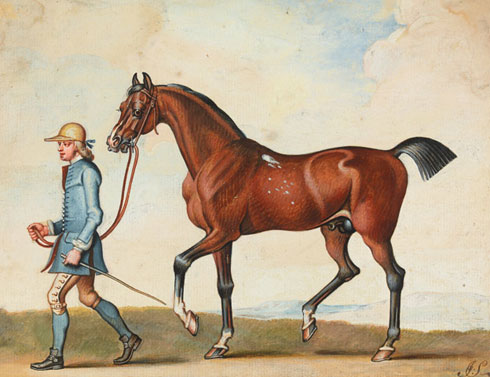The Horse: From Arabia to Ascot
By Staff Report April 30, 2012
Eighteenth Century James Seymour painting of a horse likely to be the famous Thoroughbred Flying Childers. (Photo courtesy of the British Museum)
Important loans from the British Library, the Fitzwilliam Museum and the Royal Armouries, as well as rare material from Saudi Arabia, will be seen alongside objects from the British Museum’s collection for the exhibit “The Horse: From Arabia to Royal Ascot.”
The collection will be on view at the British Museum from May 24 to Sept. 30, conveniently available to attendees of the 2012 Summer Olympics.
Though the exhibit focuses mainly on two breeds―the Arabian and the Thoroughbred―it will span domestication of the horse more than 5,000 years ago to present day and will include tack as well as art objects.
Equine domestication is thought to have first happened on the steppes of South Russia, with horses being introduced into the Middle East around 2300 BC. The development was to dramatically change the course of human history, making man more mobile, paving the way for modern armies and making agricultural development commerce possible on a much grander scale. Prior to horses, asses and donkeys were used for transport, predominantly as harness animals, but gradually horses became the means of faster transportation for early societies.
The exhibition includes one of the earliest known depictions of a horse and rider: a terracotta mould found in Mesopotamia (Iraq) dating 2000-1800 BC. Horses became a vital component in warfare and hunting, as reflected in the art of ancient Assyria, where elaborate and ornate horse trappings and ornaments were developed reflecting the prestige and status of horse, charioteer and rider.
Riding became an essential part of society during the Achaemenid period (5th -4th century BC), a cylinder seal of Darius, dating to 522 – 486 BC shows the king hunting lions in a chariot, and famously, the Achaemenid’s introduced ‘post horses’ which were used to deliver messages on the royal road. The horsemen of the Parthian Empire (3rd century BC – 3rd century AD) were celebrated by Roman authors for the ‘Parthian shot’, in which an apparently retreating rider would shoot arrows backwards whilst on horseback. The renown of Parthian horsemen is shown in their representation on terracotta plaques and bronze belt buckles in the British Museum collection.
Arabic, Persian, Turkish and Mughal miniature paintings, ceramics and manuscripts all attest to the growing importance of the horse in the Islamic world from the 7th century AD. Exquisite Mughal miniatures depict princes with their valued Middle Eastern steeds, horses that were famed for their speed and spirit. A magnificent Furusiyya manuscript, dating to the 14th century AD, on loan from the British Library, is a beautifully illustrated manual of horsemanship, including information on proper care for the horse, advanced riding techniques, expert weapon handling, manoeuvres and elaborate parade formations.
The horse has a long history on the Arabian Peninsula, becoming an important cultural phenomenon and a noted part of the traditional Bedouin way of life. The Arabian horse was developed through selective breeding. Its features including a distinctive head profile and high tail carriage that make the Arabian one of the most easily recongnized horse breeds in the world. The exhibition includes ‘Gigapan’ panorama photography of rock art which show horses in scenes of various dates from sites in Saudi Arabia, as well as loans of objects from Qaryat al-Fau, including wall paintings and figurines.

This Eastern-themed painting is among those on exhibit at The Horse: From Arabia to Ascot. (Photo courtesy of the British Museum)
The importance of fine horses in the Middle East is explored through the fascinating Abbas Pasha manuscript (dating to the 19th century and on loan from the King Abdulaziz Public Library, Riadyh). This document is the primary source of information about the lineage of the purebred Arabian horses acquired by Abbas Pasha (the viceroy of Egypt) throughout the Middle East.
The story of the Arabian breed of horse is examined in parallel to that of Wilfrid Scawan Blunt (1840-1922), poet and agitator, and Lady Anne Blunt (1837-1917), the granddaughter of Lord Byron. The Blunts travelled widely in the Middle East and established a celebrated stud for purebred Arabians, which was crucial for the survival of the Arabian breed, at Crabbet Park in Sussex, and another outside Cairo in Egypt. Horses, including Arabians had long been imported from the Middle East to Britain, but from the 17th century, three Arabian stallions in particular were introduced, which, bred with native mares, produced the Thoroughbred breed, now the foundation of modern racing; some 95% of all modern Thoroughbreds are descended from these three horses. Paintings and prints, trophies and memorabilia explore their remarkable success and their influence on sport and society, from early race meetings through to modern equestrian events.
The exhibit is funded in large part by the Saudi Equestrian Fund. Faissal Ibn Abdullah Ibn Muhammad Al-Saud, minister of education and chairman of the board of trustees of the Saudi Equestrian Fund said, “It is well known that the horse has played a crucial role in the development of civilization, and that a close bond exists between horses and men. I am very pleased that it has been possible to support this exhibition in London which gives us an opportunity to look at different aspects of the history of the Arabian horse and the context from which it emerged.” The Layan Cultural Foundation and Juddmonte Farms in association with the Saudi Commission for Tourism & Antiquities also helped to make the exhibit possible.
Admission is free. Visit The British Museum for further info.
Short URL: https://theequestriannews.com/?p=10177


